A Yagi-Uda antenna for MURS and 2-meters
| Antenna Overview |
| VHF (2m/MURS) |
| Moxon Rectangle |
| Yagi-Uda |
| High-Gain Omni |
| UHF (70 cm) |
| Dual-Rectangle |
| HDTV |
| Hoverman |
| Gapless Hoverman |
| Extended Hoverman |
| jed |
| S-Lang |
| most |
| Complex Domain Coloring |
| SLxfig |
| Antennas |
| Thermochron |
| Main Page |
The Yagi-Uda (or ``yagi'') antenna is the antenna that one most often associates with a TV antenna on a roof top. The most common form consists of a dipole driven element, a single reflector element, and one or more director elements. Such an arrangement produces a highly directional, high gain antenna. The following figure shows a schematic of a 5-element yagi:
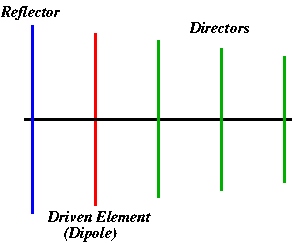
The yagi that I built was designed for the lower 3 MURS channels but was also to be usable on 2-meters. The materials that I had on hand for its construction included 1 inch diameter aluminum pipe and 1/8 inch diameter aluminum brazing rod. The design was constrained by the maximum length of the 1/8 inch brazing rod (35.5 inches), which forced me to use the brazing rod as directors and the 1 inch pipe for the reflector and driven element. The parameters of the resulting NEC-2 optimized design are given in the following table:
Element Length Boom-Position Spacing Diameter Reflector: 37-7/8 in. 0 in. 0 in. 1 in. Driven: 35-1/4 in. 17-13/16 in. 17-13/16 in. 1 in. Director: 35-1/8 in. 32-5/16 in. 14-1/2 in. 1/8 in. Director: 35-1/16 in. 56 in. 23-11/16 in. 1/8 in. Director: 34-9/16 in. 75-1/8 in. 19-1/8 in. 1/8 in.The .nec file may be found here.
NEC-2 predicted a free-space gain of over 11 dBi on the lower MURS frequences, and a front/back ratio greater than 15 dBi, as shown by the plots below.
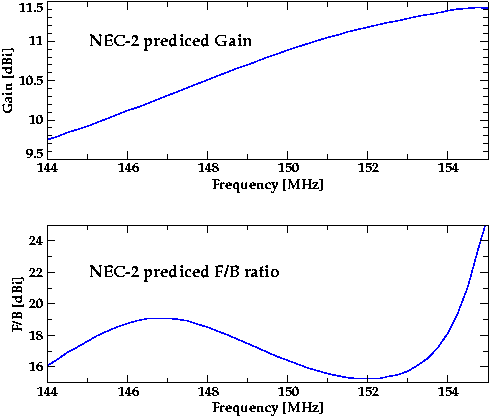
Unfortunately, I do not have the instrumentation to check the accuracy of these predictions. Instead, I was able to perform some measurements of the SWR and compare those to the NEC-2 model. The following figure shows the NEC-2 prediction of the SWR (black curve) and my measurements (blue points) of the SWR with the antenna mounted about 12 feet above the ground in the back-yard. As the figure shows, the back-yard measurements agree well with the NEC-2 model.
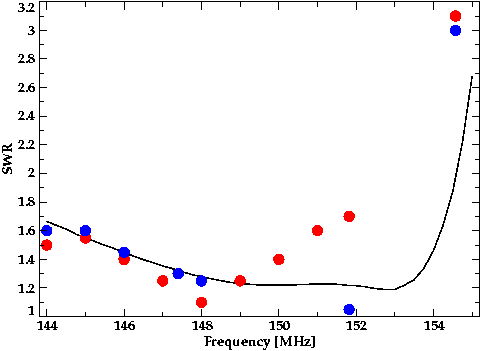
The red dots represent the measured values of the SWR with the antenna mounted in the attic. As for the case of the moxon antenna, the attic enviroment appears to have electrically lengthened the antenna. Fortunately it is still usable on the lower 3 MURS channels.
The advantage of an attic installation is that the antenna does not have to be built to withstand the weather. For the boom, I used a simple 1x2 piece of pine and mounted the antenna elements on pieces of 1x2 pine as well. The reason for doing it this way is that once constructed and tested in the back yard, the yagi had to be disassembled and then reassembled in the attic. Some of the construction details may be seen in this picture of the antenna while it was being tested in the yard (It's not pretty but it looks fine in the attic):
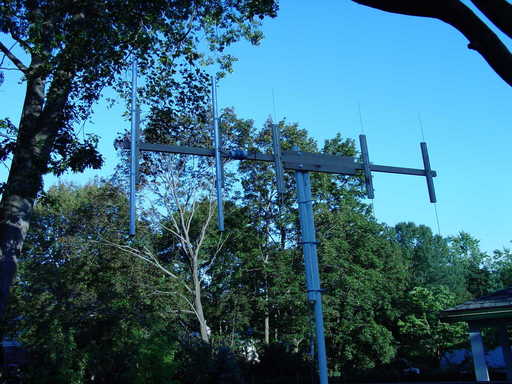
To avoid any unwanted feedline radiation resulting from feeding a balanced antenna with an unbalanced line, a simple 1-1 choke balun was created by wrapping a few turns of the coax around a piece of PVC pipe. This bit of detail may be seen in the following closeup:
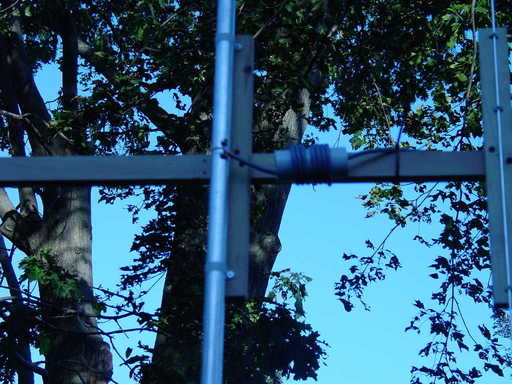
Simple tests of the attic-mounted antenna on the MURS band indicate that it performs much better than the j-pole. Additional testing on these frequencies still needs to be done. I have performed more tests on the two meter band, but lacking the proper equipment, the results are merely qualitative and rely upon the uncalibrated signal strength meter of my 2-meter radio. The images below compare the signal strength of a source as seen by the j-pole (left) and moxon (center) to that seen by the yagi (right).



Clearly, the j-pole is the weakest of the antennas, and the yagi performs the best.